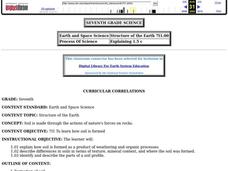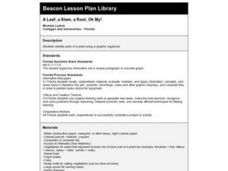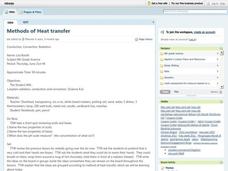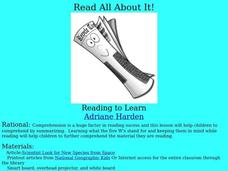Curated OER
Blood: Transport and Protection
In this blood worksheet, students review what makes up blood: plasma, platelets, and red and white blood cells. Students also learn how the blood helps fight viruses, bacteria, and other foreign substances. This worksheet has 10 fill in...
Curated OER
Clouds
Students read books, cut out shapes, and more to learn about clouds. In this clouds lesson plan, students go outside and look at cloud shapes and voice what they see.
Curated OER
Spooky Words
Students create "spooky word" sheets using white construction paper, orange and black paint, eyedroppers, and thin coffee straws. The lesson is ideal for a pre-Halloween activity. Finished artwork can be displayed around the classroom.
Curated OER
Log Cabin
Students create log cabins out of strips of construction paper in this Art lesson plan for the early-elementary classroom. Emphasis is placed on the study of how people live today versus in the distant past. A resource link is included...
Curated OER
Colors Crossword
In this language arts worksheet, students read 10 clues and place their answers in an easy crossword puzzle. Each clue pertains to a color; students decide which color answers the question and write the color name in the spaces. There is...
Curated OER
Introduction to Microsoft Word
Second graders elaborate on the classroom writing practices. They locate the various parts of the keyboard such as, space bar, shift key, delete key, etc. They also type a short piece of writing on a word processor. This is a teacher...
Curated OER
Dedication Page
Fourth graders practice using technology to create a dedication page. They use the software of Microsoft Word in order to format and save the document. The teachers provides time for independent practice. The document is then saved and...
Curated OER
Keep It Hot
Learners design and conduct an experiment to explore the insulating abilities of different materials for keeping a liquid in a paper cup warm. A small group of lab partners test four different materials: black paper, white paper,...
Curated OER
Soil Formation
Seventh graders investigate how soil is formed. They analyze types of soil samples, examine soil using a magnifying glass or microscope, complete a chart, conduct a soil and plant experiment, and construct a soil profile.
Curated OER
Physical Science: Bubble Prints
Students participate in a lab experiment involving soap bubbles and making bubble prints. They blow bubbles into the soap and add paint to make bubble prints. With extra time, they can play with a variety of bubble toys to see what...
Curated OER
Looking into Surface Albedo
Students demonstrate how the color of materials on Earth affect the amount of solar energy that is absorbed. For this solar energy lesson students complete a lab to explore how the color of materials on the Earth's surface impacts...
Curated OER
A Leaf, a Stem, a Root, Oh My!
Students conduct Internet research on plants and complete a WebQuest on vegetable plants. They use a graphic organizer to display their findings, observe actual vegetables and design a salad, noting which part of each plant is included.
Curated OER
Methods of Heat Transfer
Eighth graders are introduced to the various types of heat transfer methods. After taking a quiz, they pretend their hands are cold and offer suggestions on how to warm them up. They explain each type of heat transfer method and give...
Curated OER
Chinese Paper-Cuts
Students identify the art and culture of China while increasing their dexterity in art and their skills of papermaking. Students identify and analyze the application of the elements and principles of design to the cute of paper-making...
Curated OER
Population Dynamics
Learners watch a video on population dynamics. They conduct an experiment where they fill up a designated space with students. They recreate multiplying rabbits using beans.
Curated OER
Five Simple Poems
Students listen as the teacher explains what poetry is as well as describes several types of poetry such as haiku, free verse, limerick, cinquain, and an acrostic. Students read examples of each type of poetry. They compose a poem...
Curated OER
TOM (READING COMPREHENSION)
In this reading comprehension worksheet about "Tom", 1st graders are given 7 sentences and 4 multiple-choice questions to answer about the reading passage. Students are also given a space in which to draw a picture of their favorite...
Curated OER
The Art of Making Do
Students learn how to understand and use fabrics in a scrap quilt. They will gain the most if they can actually compose a quilt (or the beginnings of one) within class time.Quilting is a skill that is difficult for younger children to...
Curated OER
Detecting Magnetic Materials in "Martian" Soil
Pupils simulate some of the Pathfinder experiments by devising methods of collecting and measuring magnetic substances in pseudo-Martian soil. The efficiency of each of the methods used to collect materials is evaluated in this lesson.
Curated OER
Green Leaves
Third graders, after having conducted one experiment three times, record their observations results in a chart. They predict what hidden colors they believe that a leaf holds. Students record their predictions in their science note books...
Curated OER
Lake Crossing II
Students complete the following problem by using logic: Three couples, the Smiths, the Jones and the Browns wanted to go to the Brown's yacht that was moored a little way out in the lake. There was a dinghy to take them to the yacht but...
Curated OER
Discovering Albedo
Students read a thermometer accurately, collect and record data, and generate a graph based on data. They learn what independent and dependent variables are. They analyze data and make conclusions concerning how soil coverings affect...
Curated OER
Read All About It!
Young scholars are taught the comprehensions aids them in their reading and will make reading seem easier once they know what they are reading about. They access how th ask themselves the five W's: who, what, where, when, and why....
Curated OER
Wildlife Habitat
Students explain what a habitat is and describe its four elements. They see how an area's habitat suitability varies with different species of wildlife. They name factors that affect habitat suitability.























